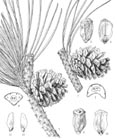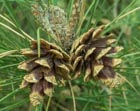
Line drawing from the Flora of China (Wu and Raven 1999).

Ornamental specimen growing by Green Lake, Seattle, Washington [C.J. Earle, 2017.01.28].

Shoot of an ornamental specimen (Seattle, WA) showing foliage and twig [C.J. Earle, 1999.02.28].

Bark of an ornamental specimen in Seattle (USA) [C.J. Earle, 1999.02.28].

Cone from an ornamental specimen in Seattle (USA) [C.J. Earle, 2004.01.12].

Tanyosho pine (a Pinus densiflora cultivar grafted to an unknown rootstock) at Green Lake, Seattle, Washington [C.J. Earle, 2017.01.28].

Cones of the Tanyosho pine (a Pinus densiflora cultivar grafted to an unknown rootstock) at Green Lake, Seattle, Washington [C.J. Earle, 2017.01.28].

Conservation Status

Pinus densiflora
Siebold et Zuccarini 1842
Common names
アカマツ aka-matsu [Japanese] (Ohwi 1965); 赤松 [Chinese]; 소나무 sonamu [Korean]; Сосна густоцветная [Russian]; Japanese red pine; Korean red pine.
Taxonomic notes
P. × densithunbergii Uyeki 1953 is the natural hybrid between P. densiflora and P. thunbergii. Synonym: P. densi-thunbergii Uyeki 1926. See Pinus thunbergii for further discussion of this nothospecies.
There are 3 varieties of P. densiflora:
- Pinus densiflora var. densiflora (syn: P. densiflora var. brevifolia Liou et Q.L. Wang; P. densiflora var. funebris (Komarov) Liou et Q.L. Wang ex Silba; P. densiflora f. liaotungensis (Liou et Q.L. Wang) Kitagawa; P. densiflora var. liaotungensis Liou et Q.L. Wang; P. funebris Komarov; P. scopifera Miquel.) (Wu and Raven 1999).
- Pinus densiflora var. ussuriensis Liou et Q.L. Wang 1958 (syn: P. densiflora f. ussuriensis (Liou et Q.L. Wang) Kitagawa; P. takahasii Nakai (Wu and Raven 1999).
- Pinus densiflora var. zhangwuensis S.J. Zhang et al. 1995 (Wu and Raven 1999).
Wu and Raven (1999) provide a key to the varieties and descriptions of each.
Description
A straight to contorted (particularly in coastal settings) tree up to 36m tall, with an open, irregular or umbrella-shaped crown. Lower branches shed early even in open settings. Bark red-brown, in large plates (on old trees) or flaky and papery. Branches grey-green, rapidly becoming smooth with age, developing papery reddish bark. Leaves green, pliable, 2 per fascicle, sheaths retained, 8-12 cm long, 0.7-1.2 mm wide, acute, with minute marginal teeth, stomata in lines on all surfaces; retained in bunches at ends of twigs. Pollen cones small, ellipsoidal, pale yellow or yellow-brown, at end of shoots. Seed cones conic-ovoid, tan to golden brown, 4-7 cm long, in whorls of 2-5 at branch nodes, remaining closed and attached for several years, on a 1-3 mm long somewhat flexible peduncle. Cone scales: about 50 scales may contain fertile seed; cuneate, the exposed part flattened, rhomboidal with a central, short-mucronate umbo; the concealed part a dark red-brown. Seeds with attached wing 10-17 mm long (Ohwi 1965, Farjon 1984). See García Esteban et al. (2004) for a detailed characterization of the wood anatomy.
In Japan, this species resembles P. thunbergii, which differs most prominently in having longitudinally fissured bark on old trees.
Distribution and Ecology
China (Shandong, Jiangsu), Korea, Japan (S Hokkaido, Honshu, Shikoko, Kyushu), and Russia: rare in southern Ussuriland on rocky slopes at 0-500 m or sandy soils, seashores, Khanka Lake islands (Harkevich and Kachura 1981, Vladimir Dinets e-mail 1998.01.10). Var. funebris found in Korea; China & Russia: Manchuria, N Ussuriland and Amur Valley (Vladimir Dinets e-mail 1998.01.10), where it grows from sea level to 600 m (Farjon 1984). It occurs from the coast into the lower mountains, sometimes reaching to 2300 m elevation (Ohwi 1965, Farjon 1984). Hardy to Zone 5 (cold hardiness limit between -28.8°C and -23.3°C) (Bannister and Neuner 2001; variety not specified).
Fires typically kill trees of Pinus densiflora, but it can quickly establish and attain dominance in the aftermath of a severe fire. Likely due to this regeneration potential, it is also a good example of a species that has been favored by human disturbance; in Japan, it was an uncommon species before about 2500 BP, when human disturbance was minimal and severe fires were infrequent. Red pine becomes prominent in the fossil pollen record at about the time that agriculture becomes widespread, and its spread in Japan is strongly correlated with the rise of agriculture (Agee 1998, Kremenetsi et al. 1998).
Remarkable Specimens
The oldest known living specimen, 107 years, was documented in a tree-ring chronology covering the period 1881-1987 (fully crossdated), collected near Hiroshima, Japan by Klaus F. Kaiser (doi.org/10.25921/5qsn-9h45). There have been few collections of this species and it is likely that substantially older trees exist. In Korean art and folklore, this species is symbolic of longevity. For example, the Jeongipum pine is said to have been growing by the roadside leading to the Beopjusa temple in Chungbuk province, Korea for almost 600 years; the tree stands today, and is greatly revered (Matthews 2019). It stands 15 m tall and is approximately 140 cm dbh, with a 19.9 m crown spread. This tree has been designated as Natural Monument No. 103 (VisitKorea, accessed 2023.11.04).
Ethnobotany
Historically, this has been one of the most important species used in Japanese architecture. The principal structural woods in most surviving structures of the Muromachi period (14th to 16th Centuries) and the Edo period (1603-1867) are Pinus densiflora and P. thunbergii, although surviving structures also contain a great deal of Chamaecyparis obtusa (Takao 2004).
Besides following agriculture as a 'weedy' species, it is also one of the more popular ornamental pines, used as such in Japan since ancient times and now widely planted in Europe and North America.
Observations
No data as of 2023.11.03.
Remarks
The epithet means "densely flowered" and may refer to the closely-set pollen cones (Farjon 2010).
I have seen an ornamental cultivar, 'umbraculifera', that bears small (3-4 cm long) cones in whorled clusters of 20-30 cones.
Citations
Agee, J. 1998. Fire and pine ecosystems, pp. 193-218 in Richardson 1998.
Farjon, Aljos. 2010. A Handbook of the World's Conifers. Leiden, Netherlands: Brill Academic Publishers.
Harkevich, S. and N. Kachura. 1981. Rare Plant Species of The Soviet Far East and Their Conservation. Nauka, Moscow (in Russian).
Kremenetsi et al. 1998. Late Quaternary dynamics of pines in northern Asia, pp. 95-106 in Richardson 1998.
Li De-Zhu. 1997. A reassessment of Pinus subgen. Pinus in China. Edinburgh Journal of Botany 54(3): 337-349.
Matthews, Jill. 2019. Sonamu, Pinus densiflora. International Dendrological Society Yearbook 2019, pp. 72-79.
Siebold, P.F. von and J.G. Zuccarini. 1842. Flora Japonica sive plantae, ... Leiden. Vol. 2(3), p. 22, t. 112.
Takao, Itoh. 2004. Architectural development of the Japanese house and wood species used for construction. http://www.nara.accu.or.jp/elearning/2004/architectural.pdf, accessed 2009.08.24, now defunct.
See also
Elwes and Henry 1906-1913 at the Biodiversity Heritage Library. This series of volumes, privately printed, provides some of the most engaging descriptions of conifers ever published. Although they only treat species cultivated in the U.K. and Ireland, and the taxonomy is a bit dated, still these accounts are thorough, treating such topics as species description, range, varieties, exceptionally old or tall specimens, remarkable trees, and cultivation. Despite being over a century old, they are generally accurate, and are illustrated with some remarkable photographs and lithographs.







